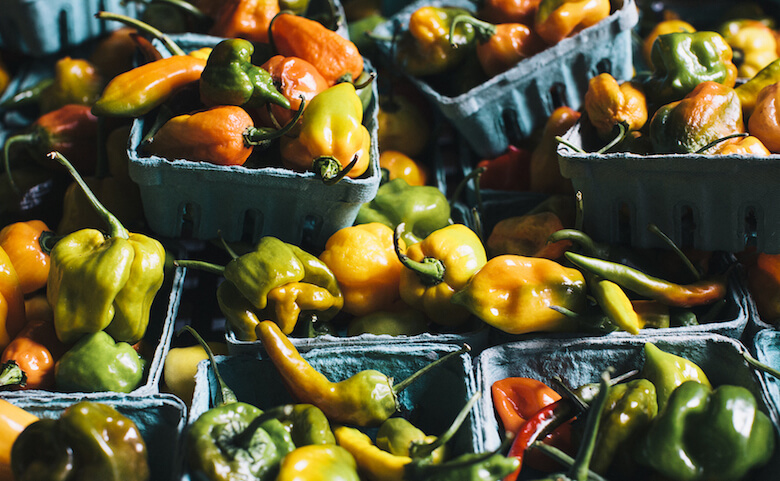
We’re longtime fans of Food Tank, aka a global community for safe, healthy, nourished eaters, and we’re republishing select new pieces to highlight some useful ideas.
The end of summer in North America is approaching fast, but gardeners, farmers, eaters and cooks can preserve summer’s bounty all year long. Fermentation, freezing, canning, and drying can all help prevent waste and make sure that families have an abundance of nutrients all year long.
Here are six simple food preservation techniques to help save the taste of summer well into the winter months.
1. Fermenting
The process of fermentation to preserve and store foods has been practiced for thousands of years. Fermenting involves a process called lacto-fermentation, which converts a food’s sugars into lactic acid, a natural preservative that inhibits the growth of harmful bacteria. Beyond preservation advantages, lacto-fermentation increases the vitamin and enzyme levels and digestibility of the fermented food. Almost any vegetable can be fermented, either singularly or in a mix of many different kinds, along with herbs and spices.
According to Sandor Katz, a renowned expert on and promoter of fermented foods, “There is no fermented food that anyone with a dedication to learning couldn’t figure out how to make.” His Wild Fermentation Portal provides a range of fermentation resources and links including books, podcasts and fermentation support forums.

2. Freezing
Freezing is one of the simplest, most convenient, and least time-consuming ways to preserve fresh produce. When foods are frozen, the extreme cold stops the growth of harmful microorganisms, reducing spoilage. Fruits and vegetables can be chopped and frozen at the peak of their ripeness, when they have optimal nutrient content, and utilized in dishes throughout the year. Fresh herbs can be preserved and frozen in vegetable oil to reduce browning and freezer burn that often occurs when herbs are frozen on their own. Paired with seasonal or frozen vegetables, it’s a simple way to have herbs readily available for Winter meals.
The National Center for Home Food Preservation provides an extensive list on how to freeze an array of foods, as well as general information concerning frozen food storage and thawing and preparing foods for serving.
3. Infusing
Infusing vinegar with Summer fruits is an easy way to bring fresh flavors into salads, marinades and cocktails when the fruits themselves have gone out of season. Almost any fruit and even some flowers can be infused into vinegar. Its high acidity level breaks down the fruit and extracts the aromas and flavors into the vinegar. Similarly, placing herbs in oil infuses the herb’s flavor into the oil, which can be used to finish a variety of foods including salads, roasted vegetables or braised meats.
The University of Georgia has compiled a flavored vinegars guide outlining the preserving process and popular flavorings and recipes.

4. Canning
Canning has been used to store foods for almost 200 years. In canning, the food is boiled in a can or jar to kill all the bacteria, and then sealed to prevent any new bacteria from getting in. Since the food in the can is completely sterile, it does not spoil. There are two home canning methods: water bath canning and pressure canning. Water bath canning is a shorter, lower-temperature canning process that is ideal for high-acid foods such as fruit, jams and jellies, chutneys, pickles, and relishes. Pressure canning is a method for preserving meats, poultry, vegetables, chili, fish, and other low-acid foods such as soups, stews, and stocks.
Canning jar company Ball provides easy, step-by-step canning guides on their website, while the Ball Blue Book Guide to Preserving and their online recipe list provide a range of tested preserving recipes.
5. Drying
One of the earliest and easiest known practices, drying refers to dehydrating food to remove all the moisture that bacteria, yeasts, and molds need to grow. It can be used for most types of foods including meats, fruits, and vegetables. Air-drying is a simple method to preserve herbs and spices by bunching and hanging them in a well-ventilated, dry, and dark place. This can also be achieved with a conventional oven or an electric dehydrator appliance.
The Home Preserving Bible website has an Introduction to the Drying Food Preservation Method that provides basic steps for oven drying foods and information on electric food dehydrator appliances.
6. Donating
In the event that there is still fresh produce to spare, donating fresh fruits and veggies to food banks that have the capacity to take them allows for the Summer harvest to be shared with those who most need it. Traditional food drives are often limited to non-perishable food items, although an increasing number of food banks are increasing their distribution of fresh food. Amp Your Good has developed a new kind of food drive called crowd-feeding that enables food drives to raise perishable food like fresh fruits and vegetables, organic food, whole meals, and lots of other healthy food. Another organization, AmpleHarvest, enables home and community gardeners to donate their excess garden produce to nearby food pantries across America.
Fresh Summer produce is best when the food is in season, inexpensive, and at its peak for flavor and nutrient content. To savor Summer’s bounty, preserving techniques such as freezing, canning, fermenting, and drying are a good alternative to boost variety and nutrition during the Fall and Winter months.
This article originally appeared on Food Tank.



